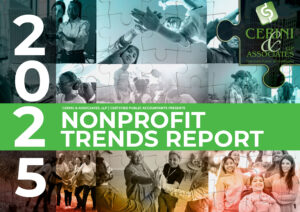As we look ahead to 2025, the economic landscape is poised for significant changes that will undoubtedly affect the nonprofit sector. Understanding these economic predictions can help nonprofits prepare and adapt their strategies to continue thriving in a dynamic environment.
Economic Predictions for 2025
1.) Steady GDP Growth
The U.S. economy is expected to experience steady growth in 2025. Goldman Sachs Research forecasts a GDP growth rate of 2.5% for the year[1]. This growth is driven by strong consumer spending, a resilient labor market, and policy changes that are expected to boost economic activity. While this is a positive outlook, nonprofits should be aware that economic growth can also lead to increased competition for donor dollars as more organizations vie for contributions.
2.) Inflation and Interest Rates
Inflation is predicted to stabilize around 2.2% by the end of 2025[2]. The Federal Reserve is expected to maintain a federal funds rate of approximately 3.5%, with a 10-year yield of 4.5%[2]. While lower inflation can ease some financial pressures on households, nonprofits may still face challenges as donors adjust their giving in response to economic conditions. Additionally, stable interest rates can impact investment income for endowments and other financial assets held by nonprofits.
3.) Labor Market Dynamics
The unemployment rate is projected to be around 4.2% in 2025[2]. A strong labor market can lead to increased disposable income, potentially boosting charitable donations. However, nonprofits may also face higher operational costs due to wage pressures and competition for skilled workers. It’s crucial for nonprofits to balance these factors to maintain financial stability.
4.) Policy Changes and Economic Impact
Policy changes, including potential tax reforms and tariff adjustments, are expected to influence the economy. For instance, the extension of the 2017 tax cuts and new tariffs on imports could have mixed effects on economic growth[1]. Nonprofits should stay informed about policy developments as these can affect both their funding sources and the economic environment in which they operate.
Impact on Nonprofits
1.) Donor Behavior and Giving Patterns
Economic stability and growth can positively influence donor behavior, leading to increased charitable contributions. However, nonprofits must be prepared for fluctuations in giving patterns due to economic uncertainties. Building strong relationships with donors and demonstrating the impact of their contributions will be key to maintaining support.
2.) Operational Costs and Resource Allocation
With a strong labor market, nonprofits may face higher operational costs, particularly in terms of wages and benefits. Efficient resource allocation and cost management will be essential to ensure that funds are used effectively to support their missions. Investing in technology and automation can help streamline operations and reduce costs.
3.) Funding and Investment Strategies
Stable interest rates and economic growth provide opportunities for nonprofits to review and optimize their funding and investment strategies. Diversifying income streams, such as exploring new fundraising avenues and enhancing grant applications, can help mitigate financial risks. Additionally, prudent investment management can ensure the sustainability of endowments and reserves.
4.) Community Engagement and Support
Nonprofits will need to focus on community-centric fundraising and engagement strategies. Building and nurturing a sense of community through local events, supporter circles, and personalized communication can foster long-term relationships with donors. Emphasizing transparency and impact reporting will also be crucial in gaining and retaining donor trust.
Conclusion
The economic predictions for 2025 present both opportunities and challenges for nonprofits. By staying informed about economic trends and adapting their strategies accordingly, nonprofits can navigate the changing landscape and continue to make a positive impact. Embracing innovation, maintaining strong donor relationships, and focusing on efficient resource management will be key to thriving in the year ahead.
Kenneth R. Cerini, CPA, CFP, FABFA
Managing Partner
Ken is the Managing Partner of Cerini & Associates, LLP and is the executive responsible for the administration of our not-for-profit and educational provider practice groups. In addition to his extensive audit experience, Ken has been directly involved in providing consulting services for nonprofits and educational facilities of all sizes throughout New York State in such areas as cost reporting, financial analysis, Medicaid compliance, government audit representation, rate maximization, board training, budgeting and forecasting, and more.






No comment yet, add your voice below!